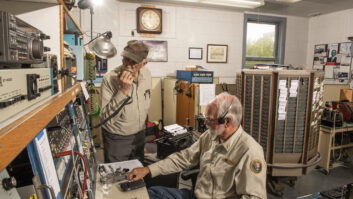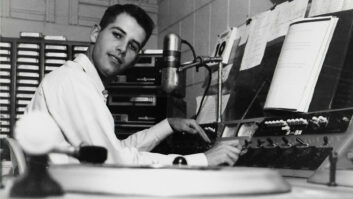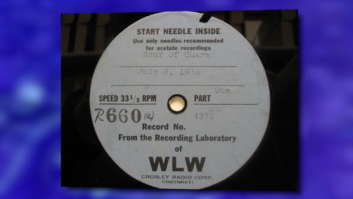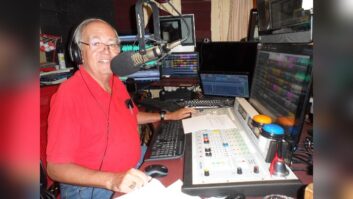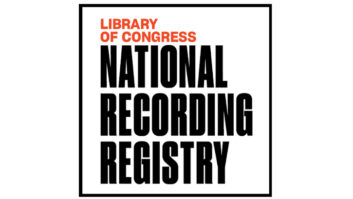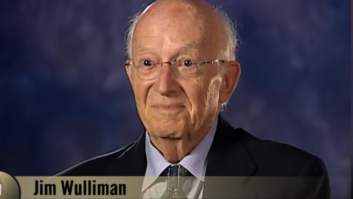Come back with us to a time before iPods or cell phones. There were no satellite channels, Internet stations or even FM as we know it. Broadcasts during this era were heard on AM and shortwave. This was radio as it existed just before and during World War II.
There was news of our battles with Germany and Japan. One could tune in to hear advice on what to do on the home front, such as buying bonds and planting Victory Gardens. And there was escapist musical entertainment courtesy of the big bands of Glenn Miller and Tommy Dorsey.
Networks carried weekly comedy shows like “Burns & Allen” on CBS and “The Great Gildersleeve” on NBC. During these years, broadcasting played an important part in the lives of Americans, and there has been a push lately to preserve this history.
While World War II-era radio waves continue to bounce out to the far reaches of the universe, it is still possible here at home to listen to the sounds of those days of ration books, the Andrews sisters and war bonds, thanks to the efforts of individuals and small groups who keep those memories alive.
(click thumbnail)Jeffrey Lunger’s site is www.wwiinerd.com.
WWII Nerd
“Back then, the flow of information was more controlled, and much slower,” said Jeffrey Lunger, owner of a Web site dedicated to archiving this type of programming.
“Reporters in these theaters of war would file a story, then someone had to type it out, send it via V-mail or call it in on a phone, if they even had a phone. Then it would make its way to the bureau office where someone would edit it and finally, it would go out to the public.”
Lunger’s site WWII Nerd — www.wwiinerd.com — contains links to fireside chats from President Franklin D. Roosevelt, diatribes from Adolph Hitler and some stirring speeches by Great Britain’s Prime Minister Sir Winston Churchill.
As recording tape didn’t come into wide use until the end of the 1940s, most of this audio was captured on disk or wire recorder as it went out over the air. Listening to these clips is like climbing into a time machine, setting the dial for 65 years ago and experiencing first-hand the chilling sounds of a world fighting for its freedom.
“Right now this site is just a hobby with me,” said Lunger, a computer professional.
“I share the cost of the Web server with some friends. Eventually when I can build up my traffic, ad revenue will come in. While I don’t expect to get rich, it would be nice to be able to pay the cost of the server.”
(click thumbnail)Marshall Azrael, Marge Wardrop and Ken Haas of the Spirit of the Air Players.
Gather ’round the radio
A staple of mid-20th century radio was the live dramatic or mystery show such as “The Lone Ranger,” “Defense Attorney” and “Flash Gordon.” These performances often included an organist, a sound effects man and, on the bigger shows, a vocal group to sing jingles for the sponsor.
With a little help from an enterprising group in eastern Pennsylvania, fresh recreations of these half-hour wonders can still be heard, if not over the air, at least by a live audience.
The Spirit of the Airwaves Players — S.O.A.P. — was founded by Jim and Marge Wardrop. She also is the artistic director of this traveling performance group.
“My husband Jim was a disk jockey on a commercial station before he retired,” said Marge Wardrop, “and he always had a fondness for old-time radio. I sang with a big band specializing in the hits of World War II, and he was the emcee for 25 years. We have about 13 people in our group on average, which covers most of our scripts. Some of the shows we re-create come from the American Library of Broadcasting at the University of Maryland, and from Temple University.”
She noted that times have changed since these shows were broadcast.
“Today’s audiences have to be re-taught to listen to radio,” she said. “They have a very short attention span.
(click thumbnail)Heather Baver as Lois Lane lets loose with a scream in recreating an episode of ‘Superman’ from 1940 called ‘Threat to the Daily Planet.’
“We have our best success with children who like the stories, and older people who have memories of the old serials. But it takes a little work to get them to use their imagination. We try to find scripts that either have a lot of action or a lot of color. A lot of patter just doesn’t work.”
These seasoned performers work their magic at retirement communities, nursing homes and historical society meetings. They travel as a self-contained unit with sound effects equipment, a PA and whatever microphones they need. The group uses reproductions of vintage 1940s mics, the 55SH Series II by Shure, that feature the outer casings of the real deal with contemporary electronics.
“None of us gets paid,” said Wardrop. “We charge a small fee that goes into equipment, scripts and whatever else we need. Everyone does it out of love for old-time radio.”
As was the case in the old days, a live show is always an opportunity for an unscripted moment.
“We were doing a ‘Superman’ program and it called for the explosion of a safe,” she said. “We were working in a big aircraft hanger for a World War II convention and it was all metal walls in there. The audience was entranced, but at the moment we were supposed to hear the effect, our sound system blew up. It made an incredible noise! That was fun to explain.”
Frequently sharing the bill with S.O.A.P. are Joe Ziegler and Bill Riley, who look like, and more importantly sound like, comedy legends Abbott and Costello.
“We can include newscasts, game shows, action serials and comedy in our show,” she said. “We dress in authentic clothes and even present musical jingles using scores written especially for us. It’s tough taking our big show on the road but fortunately we have people who are enthusiastic. No one ever says, ‘When do I get paid?’”
Find out more about S.O.A.P at www.soapradioactors.org.
Repository
Bill Schurk, professor and sound recording archivist at Bowling Green State University in Ohio, is in a unique position to discuss the preservation of bygone eras.
His Music Library and Sound Recording Archives is a repository for all sorts of music and spoken-word recordings going back 100 years.
“These World War II radio shows have been saved in a number of formats,” he said. “Worst of all, on cassette, but on open tape reels, original acetates, LP reissues and in digital format.”
Schurk mentioned V-Discs, an army project conceived by Robert Vincent that produced material for servicemen and women overseas. While the recording industry was on strike during part of that time, the company was allowed to record by special permission from industry and labor groups. V-Discs were supposed to be destroyed after the war, but recordings survived.
A number of these reside in the archives at BGSU. For information on this era, visit community.mcckc.edu/CROSBY/v-discs.htm.
Schurk suggested another online resource for World War II era recordings, www.chirotoons.com/1homefront.html.








